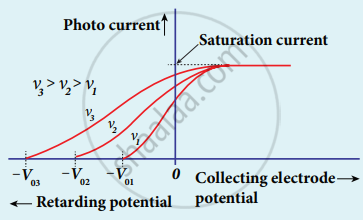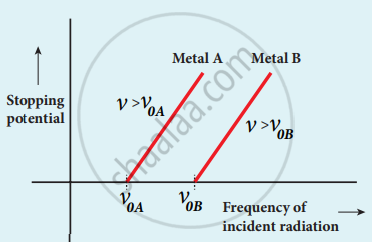Advertisements
Advertisements
Question
Explain how frequency of incident light varies with stopping potential.
Solution
1. The effect of frequency of incident light on stopping potential can be studied by keeping the intensity of the incident light constant.
2. The electrode potential varies for different frequencies of the incident light.
3. As the frequency is increased the photoelectrons are emitted with greater kinetic energies so that the retarding potential needed to stop the photoelectrons is also greater.

Variation of photocurrent with collector electrode potential for different frequencies of the incident radiation
4. From the graph between frequency and stopping potential, the stopping potential varies linearly with the frequency of the incident light.
5. The stopping potential is zero when no electrons are emitted below a certain frequency called threshold frequency.

Variation of stopping potential with frequency of the incident radiation for two metals
APPEARS IN
RELATED QUESTIONS
Two radiations with photon energies 0.9 eV and 3.3 eV respectively are falling on a metallic surface successively. If the work function of the metal is 0.6 eV, then the ratio of maximum speeds of emitted electrons in the two cases will be
Photons of wavelength λ are incident on a metal. The most energetic electrons ejected from the metal are bent into a circular arc of radius R by a perpendicular magnetic field having magnitude B. The work function of the metal is
What is the photoelectric effect?
How does photocurrent vary with the intensity of the incident light?
How will you define threshold frequency?
What is a surface barrier?
Mention the two features of x-ray spectra, not explained by classical electromagnetic theory.
Explain the quantum concept of light.
Give the construction and working of photo emissive cell.
A 3310 Å photon liberates an electron from a material with energy 3 × 10−19 J while another 5000 Å photon ejects an electron with energy 0.972 × 10−19 J from the same material. Determine the value of Planck’s constant and the threshold wavelength of the material.
